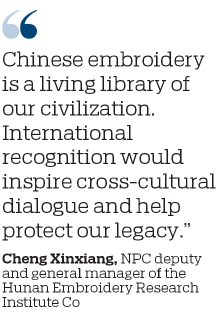Deputy passes down traditional embroidery heritage

As a two-term deputy to the National People's Congress and a leading inheritor of Hunan embroidery, a national intangible cultural heritage, Cheng Xinxiang has spent decades weaving tradition into modernity, in order to keep the ancient craft surviving and thriving in the digital era.
Over the past year, her dual roles as a national legislator and cultural inheritor have converged into a single mission: to redefine the future of Chinese embroidery through innovation, policy advocacy and youth empowerment.
Cheng, general manager of the Hunan Embroidery Research Institute Co, proposed at last year's two sessions — the annual meetings of the nation's top legislative and political advisory bodies — to utilize technology to empower traditional Chinese culture, which has become a catalyst for change.
Collaborating with tech experts, the 52-year-old pioneered a program to use artificial intelligence in the digital generation of Hunan embroidery.
This innovation slashed the time required to draft traditional blueprints for embroidery patterns from weeks to hours, greatly enhancing production efficiency, she said.
The use of technology fueled their collaborations with institutions like the Changsha Museum to launch digital embroidery postcards that feature iconic cultural relics and whimsical jewelry lines, blending historical motifs with contemporary aesthetics, Cheng said.
She has also championed a digital ecosystem that integrates R&D, production, inventory and sales management for the Hunan embroidery industry.
During this year's two sessions, her vision turned global.
Teaming up with Suzhou embroidery master Yao Jianping, who is also a NPC deputy, she proposed working toward getting China's diverse embroidery traditions onto UNESCO's Intangible Cultural Heritage list.
"Chinese embroidery is a living library of our civilization," she said. "International recognition would inspire cross-cultural dialogue and help protect our legacy."
Cheng is also paying special attention to cultivating young talent for embroidery.
To combat the exodus of young talent, she has established three mentorship studios to provide training for over 60 artisans, three of whom have been named provincial-level inheritors.
She said the difficulties faced by young embroiders in terms of career advancement posed the main challenge for the industry's development.
More than that, some enterprises have tarnished the brand of Hunan embroidery by selling substandard pieces.
She suggested that the government provide more career opportunities and salary incentives for embroidery inheritors and actively promote their stories on media platforms.
To win over young fans, Cheng said her team has repositioned traditional embroidery as a dynamic and relatable craft. Through collaborations with popular milk tea brand Chayan Yuese, from dairy packaging to the decoration of trendy tea shops, they have further embedded embroidery into daily life.
The latest breakthrough of Cheng's team — 3D embroidery — epitomizes their innovative spirit.
Cheng is a fourth-generation inheritor of the pengmao stitch in Hunan embroidery, which is a specialized needlework technique that creates realistic, 3D animal fur textures through layered, irregular stitching.
By reimagining the traditional pengmao stitch, her team created hyper-realistic embroidered horse images that appear to leap from the canvas, blending depth, light and texture.
Despite progress, challenges remain. Cheng said over 80 percent of Hunan embroiderers are older than 50 years old, highlighting an urgent need for youth engagement. "We must meet young people wherever they are," she said.
Reflecting on her 36-year journey, she credits her mentors for giving her unwavering dedication. "As an apprentice, I nearly quit countless times. But my teachers taught me that mastery demands 'eating bitterness' — persisting through monotony and setbacks," she said.
Becoming an embroidery master is a pilgrimage of the body and mind, she said. Today, as a mentor, her pride lies in nurturing a new generation.
"When I see a 20-year-old's embroidery skill rivaling a master's, I know the craft will live on."
For Cheng, the fight to preserve Hunan embroidery is a deeply personal choice. "Every stitch carries the soul of our ancestors. My duty is to ensure those threads weave into tomorrow's tapestry," she said.
zoushuo@chinadaily.com.cn























